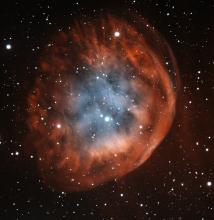Listen to today's episode of StarDate on the web the same day it airs in high-quality streaming audio without any extra ads or announcements. Choose a $8 one-month pass, or listen every day for a year for just $30.
You are here
Fast Bursts
When astronomers find a new type of object that goes “boom,” it takes a while to explain it. They have to figure out how far away the objects are, which reveals how bright they are. And they have to see them at different wavelengths to understand what they’re doing.
They’re just starting that process for a class of objects known as fast radio bursts — blasts of radio waves that last no more than a few thousandths of a second. The first was discovered in 2007, and a few dozen others have been seen since then.
Theorists have proposed several explanations for the bursts — from mergers between stellar corpses, to flares on the surfaces of highly magnetized corpses.
The effort to understand them has been stymied because astronomers hadn’t seen any of the bursts at other wavelengths. But that changed with a burst that was discovered in November of 2013.
A space telescope was looking at the same region of sky where the radio burst was discovered. An analysis, reported late last year, showed that the burst was accompanied by a blast of gamma rays, which are produced by some of the most violent events in the universe.
That means that this particular burst took place far outside our home galaxy, so it had to be extremely energetic. That eliminates some possible explanations for the burst. But astronomers say that different bursts could have different causes. So it’ll take a while to fully understand the diverse nature of fast radio bursts.
Script by Damond Benningfield






